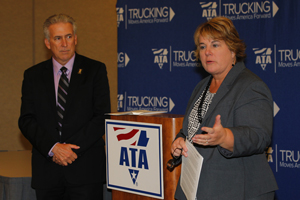HOS Tops Industry's Critical Issues List Again

SAN DIEGO — The hours-of-service rule once again topped the American Transportation Research Institute’s annual survey of critical issues facing the trucking industry, while several driver-focused concerns moved higher up the 2014 list.
The survey of more than 4,000 industry stakeholders was released here Oct. 6 during American Trucking Associations’ Management Conference & Exhibition.
MC&E 2014: Complete coverage
The survey “gives us direct insight into all of the complex forces affecting motor carriers and drivers so that we can plan accordingly and focus on running a safe and profitable industry,” said Philip Byrd Sr., CEO of Bulldog Hiway Express and the outgoing ATA chairman.
ATRI said the operational costs related to the HOS changes that went into effect in July 2013, restricting use of the 34-hour restart and requiring a 30-minute break after eight hours, kept the issue at the top of the 2014 list.
Still, both Rebecca Brewster, president and CEO of ATRI, and Mike Card, president of Combined Transport and a former ATA chairman, expressed surprise that HOS eclipsed driver shortage in the rankings.
Brewster noted that in the survey, motor carriers identified driver shortage as the No. 1 issue, but overall, HOS came out on top.
"If you look at the overall top 10, five or six of these are directly related to drivers," Card noted. "Drivers are the No. 1 important issue today."
Card added that at Combined Transport, the average age of his drivers is 58.
"We've had meetings in our company, that said, in 10 years, will our average age be 68? Maybe not quite that much, but our drivers are getting older," Card said. "And we don't see where the next generation of drivers is going to be coming from. So if I was asked, I'd probably put that No. 1."
Survey respondents recommended suspending the restart provision until further safety and economic studies are conducted and to advocate for increased sleeper-berth flexibility.
The driver shortage not only moved up one spot this year to No. 2 on the list — it also was listed by 24% as the largest issue facing the industry, compared with 19% for HOS.
ATRI said fleets and their customers continued to experience a capacity crisis due to the shortage of qualified drivers, and ATA projects the deficit could grow as large as 240,000 open positions by 2022.
Recommended solutions to the shortage included working with federal and local officials to develop a graduated commercial driver license program to attract new and younger drivers. Additionally, the industry should conduct more research to document successful recruitment strategies and work to further streamline the transition from a military CDL to a civilian CDL to attract more veterans.
The complete list, compared to last year's rankings:
3. The Compliance, Safety, Accountability program (No. 2 in 2013)
4. Driver retention (No. 7)
5. The electronic logging mandate (No. 5)
6. Truck parking (No. 6)
7. Transportation/infrastructure/congestion/funding (No. 9)
8. Driver health/wellness (No. 10)
9. The economy (No. 4)
10. Driver distraction, only new entrant to this year’s list.
Additional coverage of the ATRI Top 10 will be included in the Oct. 13 print edition of Transport Topics.

